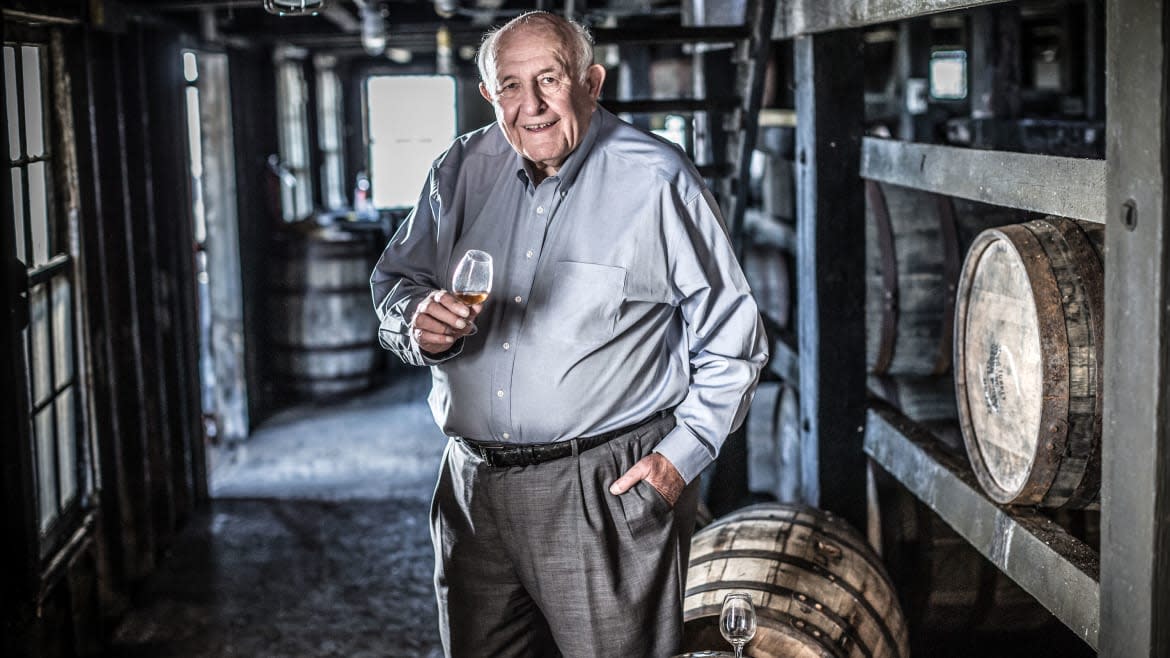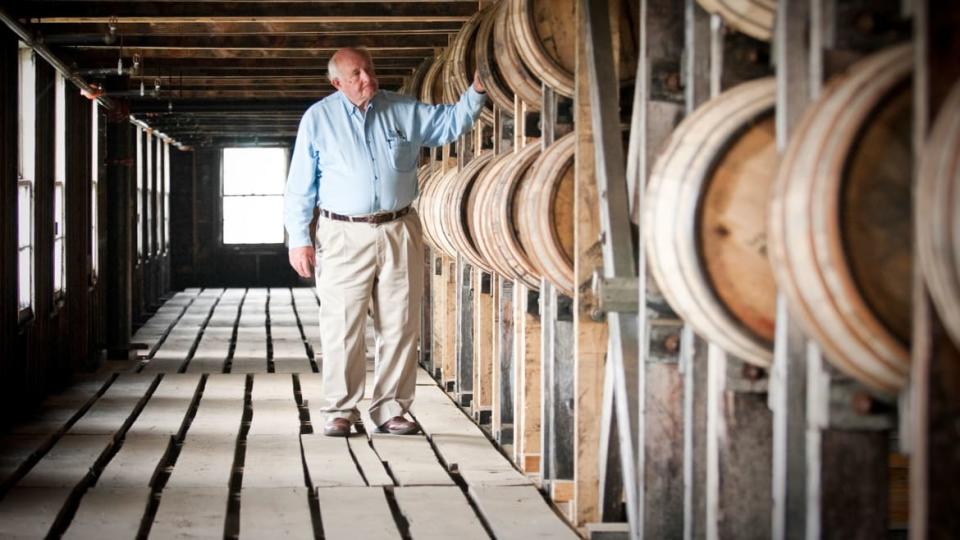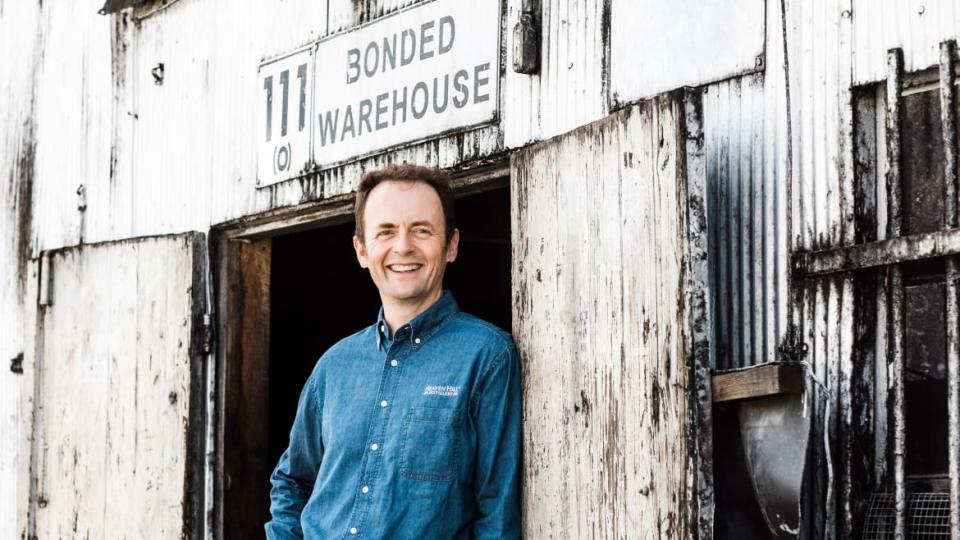Stop Wasting Your Money on Bourbon That’s Too Old

The biggest difference between Scotch and bourbon isn’t where they’re made, what they’re made from or even the use of peat smoke.
It’s the new, charred oak barrel that bourbon legally must be aged in. That’s why a 10-year-old bourbon is ruddy and brown, full of vanilla and caramel, and wrapped round with firm oak spice and a hint of tannic structure.
Building a Whiskey Empire in 85 Years
Are the Manhattan & the Martini the Same Cocktail?
On the other hand a 10-year-old Scotch is aged in a used barrel. While some brands use old sherry casks, most Scotch is aged in used bourbon barrels. Either way, the barrel’s influence has mellowed, with its robust colors and strong flavors already pulled out of it.
That 10-year-old Scotch is just coming of age, but the 10-year-old bourbon may be at the crest of the hill. Ten Kentucky summers have hammered it deep into the fresh wood of that barrel, and ten ice storm filled winters have pulled it back, carrying vanillin, tannin and other flavors with it.
Most bourbons don’t even go that long in the wood. Sure, the flagships, like Jim Beam White, Evan Williams and Old Forester are under 10 years, but so are whiskies that get wide critical acclaim, like Booker’s, the Thomas H. Handy Rye from the Buffalo Trace Antique Collection and Wild Turkey Rare Breed.
Because of that new barrel and the hot Kentucky climate, bourbon gains color and flavor quickly. If aging goes too long, it will become almost undrinkable. The trick is finding the sweet spot.
Seven years ago, I talked with Jimmy Russell, the iconic master distiller for Wild Turkey, at WhiskyFest New York. In front of 400 steaming whiskey geeks (who couldn’t wait to get their lips on a promised 21-year-old Stitzel-Weller sample that looked dark as espresso), I asked Russell how he felt about the age of bourbon. Right around eight years was best, I recall him saying, and no real need to go past 12; after that, the wood takes over.

I called him recently to confirm his feelings about that sweet spot for bourbon. “Anywhere from 6 to 12 years old,” Russell said. “You see where the Russell’s Reserve is: 10 years. I like anything from 8 to 10 years, maybe 12. No older than that.”
“When we’re tasting,” he continued, “if we taste something that’s aging well, we’ll put [those barrels] aside and keep tasting them. When they start getting that woody taste, we’ll start moving them down to the [cooler] bottom floors. We can’t move thousands, but 100 to 150 barrels, we can control the aging of it. We’ve always done that. At the perfect age, we’ll bottle them.”
That made me think of something that Fred Noe, Jim Beam master distiller, told me his father, bourbon legend Booker Noe, used to say about making bourbon by taste, not age. “Dad said it’s like being the guy that owns the orchard; you want to pick the apples when they’re ripe. We pull the barrels when they’re ripe.”
If Russell’s sweet spot for bourbon is 6 to 12 years (and pretty much everyone else I talked to agreed), what are you looking at on either side of that range?
When Wild Turkey is younger than that, Russell doesn’t want to use it. “To me, it hasn’t matured yet,” he said. “I call it a grain taste, a yeasty taste. I get a grainy yeasty taste in 4- to 5-year-old whiskey. It takes a little longer.”
And so, what does “too old” taste like? “I like to tease,” Russell said, and chuckled. “If it’s over 12 years old and it wasn’t controlled, you could just get a stick of white oak and start chewing on it! That’s that woody taste, and I just don’t like a lot of woody taste. I like the combination of the wood and the whiskey.”
Russell is what we call a practical distiller, who learned the art of distillation by observation and apprenticeship.
Over at Heaven Hill, master distiller Conor O’Driscoll is much more a scientific distiller. He will tell you about esters and acidification, numbers and compounds. But he’s also practical. I asked him about bourbon aged for more than 20 years. “Expensive whiskey that tastes like a dirty old stick?” he asked with a hoot. Mind you, this from the master distiller/blender at a company that has put out a 27-year-old bourbon. So I asked him about that.
“The 27 we brought out was interesting. The most interesting thing is that it was 27-years-old, and it was still decent,” he said. “But of all the 27-year-old barrels we had, we bottled a third of them. The other two-thirds were not drinkable. We have younger barrels that taste a lot better.
“Look at Elijah Craig: 8 to 12 years old, and nailing that sweet spot,” he explained. “Elijah Craig was designed to showcase how we mature. We have 1.9 million barrels in 61 warehouses. The [warehouses are] old, new, in the city and country, made of brick, wood, whatever. As we build a batch of Evan Williams, Elijah Craig, Henry McKenna, we have all those levers to pull.”

Catch a bourbon too young, and what is it like? “The easiest answer: it’s raw,” O’Driscoll said. “There might be multiple different flavor components, but they’re episodic. You’re going to taste grainy whiskey, green apple, barrel character, but they’re not going to be a complex harmonious whole, they’re going to be one after another, not the mellow blend we expect from good bourbon.”
And on the other side? “Too much wood extraction, first,” he said. “You’ve gone through the red and toasted layers, and now you’re getting those raw wood notes. You’re getting more oxygen, and you’re getting acetone. It’s one of the last stages of the degradation of complex organics. That’s where that nail polish remover [aroma] comes from. All those critical components that make a good bourbon great have gone too far. You’re getting dirty old stick flavors, breaking alcohols into acetone, and it’s getting thicker and thicker, and concentrating stuff that might be better at a dilute concentration.”
That sounds nasty. So, when did we decide we wanted really old bourbon, and why?
“American whiskey wasn’t really aged at all until the 1850s,” says Chuck Cowdery, author of several books on bourbon and publisher of The Bourbon County Reader. “James Crow was the first person to sell only aged whiskey; that was his distinction, besides perfecting the sour mash process. It probably wasn’t even two years old, but it had gone into a new barrel. New make, what they called ‘common whiskey,’ was selling for a dime a gallon, and Crow was getting a quarter. Through the 1850s, you might see advertising for whiskey advertised as 1 year old, or two years old.”
Even after this lightly aged whiskey caught on, government policy led to younger whiskey being the common product. Before 1894, according to Reid Mitenbuler, author of Bourbon Empire, bourbon was sold younger because distillers had to pay taxes after it was aged for just a year in a bonded warehouse. While they could age it longer, thanks to the angel’s share—the annual loss of whiskey to evaporation—there was no incentive to go past one year.
“Distillers thought, ‘I paid my taxes, but the liquid I paid taxes on is going to evaporate, so I’m going to sell it.’” he said. “In 1894, John Carlisle got the bonding period pushed to 8 years.”
That’s Secretary of the Treasury John Carlisle, a Kentuckian, and one of the conservative Democrats who were known as the Bourbon Democrats. With the bonding period set at a maximum of 8 years, there was no advantage to aging whiskey any longer than that. “After 8 years, you had to take it out of bond, pay the taxes and sell it,” said Michael Veach, author of Kentucky Bourbon Whiskey; An American Heritage. “If you put it back [in the warehouse], you were losing money.”
Eight years of aging worked for the industry, for the government and for the happy drinkers, for about 20 years. Then came Prohibition, followed relatively quickly by World War II, which left bourbon brands scrambling for whiskey to sell. After running through the terribly woody whiskey that had been made before Prohibition and somehow survived, they sold desperately young whiskey at cheap prices, barely staying afloat. Bill Samuels Jr., the emeritus head of Maker’s Mark, told me his father used to refer to those sales as “swapping dollars,” with suppliers, distillers, and retailers making just enough to pay each other.
When the Korean War exploded in 1950, distillers were determined they wouldn’t get caught short again. They made bourbon as fast as they could, stuffed it into warehouses and congratulated each other on their wisdom. But the Korean War didn’t last long enough to have anywhere near the impact that World War II had on the industry. Now the distillers were on the other end of a supply problem.
“They had all over-produced,” said Mitenbuler. “It was enough for eight years of consumption at the time. It was way more whiskey than they knew what to do with...and all that tax is coming due in eight years.”
The Hunt for Rare Geo-Targeted Whiskies
Get These Limited-Edition Whiskies Before They Sell Out
After intensive lobbying, the bonding period was extended to 20 years in 1958, giving the industry more time to sell the whiskey before the tax was due. (“It also allows you to just let it evaporate out of existence so you never get taxed on it,” Mitenbuler shrewdly noted.)
That’s when age became a selling point for bourbon. “A lot of industries are moving to luxury at this point,” said Mitenbuler. “How can we improve the image and get more money for it? Age. Scotch sells on ‘older is better,’ and so does wine.” That’s when you started seeing premium bourbons at 10 and 12 years old. The image of bourbon changed from a Southern guzzle to America’s spirit, a noble drink. Everything was looking great for American whiskey.
Then Americans gradually stopped drinking bourbon. Not entirely, of course, but the volume dropped by half, which was catastrophic for the industry. Once again, brands had a glut of whiskey to deal with that would last for years.
What to do? The answer was starting to appear on liquor store shelves: single malt Scotch with age statements, building the idea that ‘older is better.’ It had pulled Scotch whisky out of their glut situation in the early ’80s; maybe bourbon could do that, too. We soon had “small batch,” “single barrel vintage” bourbons that were 7, 10, 15 and 20 years old. And it worked! Older bourbon sold for higher prices and it burnished bourbon’s image.
But it led drinkers, in our inexperience, to think bourbon should be compared to Scotch and to Scotch’s age in the barrel. Again: bourbon isn’t Scotch. There’s a lot of difference between 20-year-old single malt and 20-year-old bourbon, and folks, for bourbon, it ain’t a good difference. I can remember when I first realized that the reason bourbon wasn’t as old as Scotch wasn’t because it wasn’t as good, or because it was cheap; it was because it was fundamentally different in how it was made.
I’ve talked to a number of distillers, blenders and brand ambassadors about this, and off the record, they almost uniformly will tell you that whiskey aged in a new barrel should rarely go past 15 years. But we got the idea that older is better from Scotch whisky, and we ignore the very different aging regimens: new, charred oak barrels aging in hot warehouses in hot summers. We want 20-year-old bourbon, dammit!
Well, if that’s what the market wants, maybe there’s a way to make a whiskey that tastes consistently great at 15, 18 and even 22 years old. Buffalo Trace is taking a radical approach with what it calls Warehouse P. It’s a simple proposition. The company aims to create a 50-year-old bourbon by aging the whiskey at a constant 45° F.
It’s not as simple as you’d think. It turns out that the whiskey is aging in ways that are not just slower, but significantly different. Master distiller Harlen Wheatley isn’t ready to release details yet (he notoriously keeps his cards close to his chest), but he did say that the aging has taken different pathways. “It has introduced different interactions that have developed the flavors. We are still reviewing the evaporation, but it appears that it is similar to the standard evaporation rates. However, we know that it will be altered along with the flavor.”
Coopers have been doing a lot of experimenting with treatments to oak barrel staves—deep toasting, flash-charring, slow-roasting—things that sound almost culinary. Maybe there is a way to make a barrel that could age a great 20-year-old bourbon, without pounding too much tannin and such into it?
I asked Andrew Wiehebrink about that. He’s the director of spirit research and innovation at Independent Stave Company, the outfit that makes the barrels for much of the bourbon industry. He started his explanation at the other end of whiskey’s sweet spot.
“There’s all sorts of things we can do to make bourbon taste better at 4 or 5 years,” he said. “That’s the normal aim. Take that char profile and set it closer to the inside surface of the stave; you get all the complexity of a char number 4, but you just get it sooner.” That gets you good-tasting whiskey sooner, and more of it, with less evaporation.
But what about the far end? Can you make a slow-aging barrel?
“The question is,” Wiehebrink said, without quite making it sound like I was nuts,“why do you want to create a 30-year-old bourbon if the 12-year- old tastes good? For some reason, this concept of making a 30-year-old bourbon has taken hold. It’s kind of a strange goal. It costs more money, it takes more time and for what? It tastes great at 8 years old.”
He laughed then, and said, “it does make my job really interesting, so that’s good.”
I’ll leave the last word to Fred Noe. I got in touch with him because it had occurred to me that unlike some of the other distillers, you rarely see anything older than 12 years from Beam. One such whiskey that they did release was the Booker’s Rye at 13 years old. He allowed that Beam’s rye, typically, is not as beautifully balanced as that one was at such an advanced age. (Okay, I added the “beautifully” part, because it was.)

“Can we do it again?” he wondered. “We don’t know. We looked at it. When you’re looking at wood, barrels, seasons…you can put the same whiskey in the same warehouse and it might not come out the same. There are variables you can’t control 100 percent. They all come into play in creating something special.”
And then he said, “more times than not, old bourbon is just old bourbon.”
Get our top stories in your inbox every day. Sign up now!
Daily Beast Membership: Beast Inside goes deeper on the stories that matter to you. Learn more.

